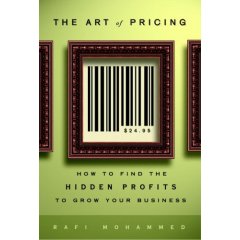 Figuring out the price of products is so hard. Should you charge $5.95 for a product, or $10.95? Their are so many different areas that this will impact — for one, the survival of your company!
Figuring out the price of products is so hard. Should you charge $5.95 for a product, or $10.95? Their are so many different areas that this will impact — for one, the survival of your company!
I was rather pleased to stumble upon a book about pricing at Borders. It is called The Art of Pricing: How to Find the Hidden Profits to Grow Your Business. At first I thought “what can be learned from a book about pricing?” but I was rather surprised.
The book uses many real-life examples. There are stores about how Ford lowered prices on higher margin products to encourage less sales of lower margin products. As a result, they significantly increased sales of premium upgrades because the value was greater.
Similarly, a restaurant example showed how you could attract different types of customers using “early bird discounts” to attract penny pincers but limiting those to sales to times when foot traffic was lower.
This is a great book that gives ideas and examples to help you price your products or services. But more than that, it gives you creative ideas for pricing that you might not think about and that could prove extremely profitable.
Economist magazine gives the following pricing options to people who want to subscribe:
* Website-only subscription: $59.00 per year.
* Print-only subscription: $125.00 per year.
* Print & web: $125.00 per year.
David Airey, a behavioral economist himself is confused: why would the Economist offer the same price for print-only subscription as well as for print & web subscription? It didn’t make sense to him.
So David started investigating and found out why Economist gave the 2nd print-only option that they knew no one would go for.
He gathered 2 groups of 100 students each and asked them to subscribe to the Economist. To the first group, he made the same offer that the Economist makes. And the results of what people chose are:
* Website-only subscription: 16
* Print-only subscription: 0
* Print & web: 84
For the 2nd group, David removes the 2nd print-only pricing option. The results this time are:
* Website-only subscription: 68
* Print & web: 32
Economist gives the 2nd pricing option that they know no one will buy because it increases the number of sales their higher priced 3rd option gets!
Action Summary:
* People don’t make decisions in a vacuum. They make them by comparing various factors with each other.
* People pick an anchor and base their final conclusion near and in comparison to that anchor. So make sure that the answer you want is close to the anchor point.
* To persuade people, change their frame of mind by giving them a different anchor point. And they’ll decide in your favour.